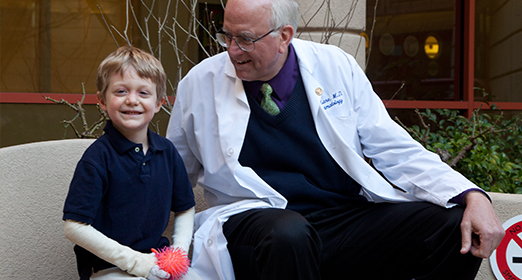I’m often humbled by my job. Well, not the job, exactly, but the physicians, researchers, and especially patients who take the time to speak with me about their goals and passions, their triumphs and fears. Their insight helps me as I struggle to interpret what goes on here at the Stanford University School of Medicine for others across the university and even around the world.
But every once in a while, an article comes along that brings me to my (emotional) knees. My article “The Butterfly Effect” in the latest issue of Stanford Medicine magazine describes the toll of a devastating skin disease called epidermolysis bullosa on two young men and their families, as well as the determined efforts of a dedicated team of doctors and scientists to find a treatment. As a result, Stanford recently launched the world’s first stem-cell based trial aimed at correcting the faulty gene in the skin cells of patients with a severe form of the condition, which is often called EB.
I trace the path of one family as they learn, mere hours after his birth, that their son, Garrett Spaulding, has EB, which compromises the ability of the outer layers of the to stick together during friction or pressure. Patients develop large blisters and open wounds over much of their bodies. It’s incurable, fatal, and nearly indescribably painful. Paul Khavari, MD, PhD, now the chair of Stanford’s Department of Dermatology, was a young doctor at the time newborn Garrett was admitted to Lucile Packard Children’s Hospital Stanfordin 1997.
“His whole body, his skin was blistered and falling off everywhere someone had touched him,” Khavari recalls in the article. “His parents were devastated, of course, at a time that was supposed to be one of the most joyful of their lives.”
Garrett’s now 18 years old, but the disease is taking its toll.
You’ll also meet Paul Martinez, one of the first participants in Stanford’s new clinical trial. He’s 32, which makes him an old man in the EB community. Unlike many EB patients, he has finished high school and completed a college degree in business marketing with a dogged determination that makes me ashamed of my petty complaints about my minor life trials. And he’s done it without relying on the pain medications essential for most EB patients. As he explains in the article:
We don’t know what it is like to not be in pain. It’s just normal for us. […] I have a very high tolerance, and don’t take any pain medication. I cherish my mind a lot. Rather than feel like a zombie, I prefer to feel the pain and feel alive.
Stanford dermatologist Jean Tang, MD, PhD, also reflects on the frustration of doctors who want only to help their patients:
Of all the skin conditions we see in dermatology, EB is the most completely debilitating and awful. If we could cure only one condition in this field, it would be EB, hands down. I don’t know any dermatologist who would answer differently. It’s hard for healthy people to realize just how important your skin is and how limited EB patients’ lives are.
The story was tough to write, but I’m hopeful that it, and the accompanying video (produced by my talented colleague, Mark Hanlon), will serve to raise awareness of this disease. I was pleased to see that it was featured on LongReads last Wednesday, which should increase its reach, and more than one person has told me they had tears in their eyes as they read about Paul and Garrett. I’m honored and humbled to be allowed to tell these patients’ stories.
This article first appeared in Scope.
